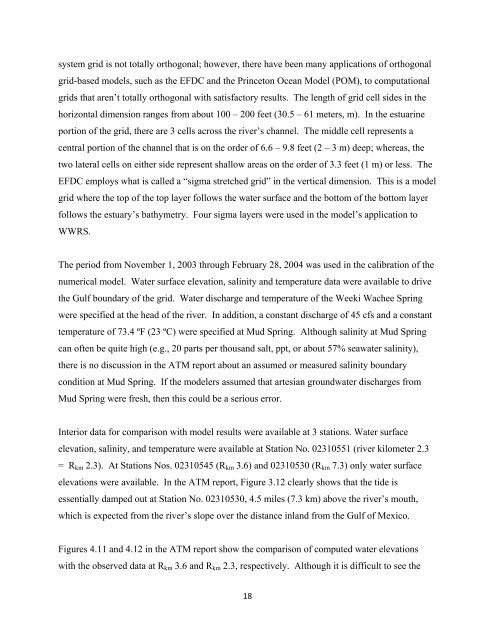Weeki Wachee River System Recommended Minimum Flows and ...
Weeki Wachee River System Recommended Minimum Flows and ...
Weeki Wachee River System Recommended Minimum Flows and ...
You also want an ePaper? Increase the reach of your titles
YUMPU automatically turns print PDFs into web optimized ePapers that Google loves.
system grid is not totally orthogonal; however, there have been many applications of orthogonal<br />
grid-based models, such as the EFDC <strong>and</strong> the Princeton Ocean Model (POM), to computational<br />
grids that aren’t totally orthogonal with satisfactory results. The length of grid cell sides in the<br />
horizontal dimension ranges from about 100 – 200 feet (30.5 – 61 meters, m). In the estuarine<br />
portion of the grid, there are 3 cells across the river’s channel. The middle cell represents a<br />
central portion of the channel that is on the order of 6.6 – 9.8 feet (2 – 3 m) deep; whereas, the<br />
two lateral cells on either side represent shallow areas on the order of 3.3 feet (1 m) or less. The<br />
EFDC employs what is called a “sigma stretched grid” in the vertical dimension. This is a model<br />
grid where the top of the top layer follows the water surface <strong>and</strong> the bottom of the bottom layer<br />
follows the estuary’s bathymetry. Four sigma layers were used in the model’s application to<br />
WWRS.<br />
The period from November 1, 2003 through February 28, 2004 was used in the calibration of the<br />
numerical model. Water surface elevation, salinity <strong>and</strong> temperature data were available to drive<br />
the Gulf boundary of the grid. Water discharge <strong>and</strong> temperature of the <strong>Weeki</strong> <strong>Wachee</strong> Spring<br />
were specified at the head of the river. In addition, a constant discharge of 45 cfs <strong>and</strong> a constant<br />
temperature of 73.4 ºF (23 ºC) were specified at Mud Spring. Although salinity at Mud Spring<br />
can often be quite high (e.g., 20 parts per thous<strong>and</strong> salt, ppt, or about 57% seawater salinity),<br />
there is no discussion in the ATM report about an assumed or measured salinity boundary<br />
condition at Mud Spring. If the modelers assumed that artesian groundwater discharges from<br />
Mud Spring were fresh, then this could be a serious error.<br />
Interior data for comparison with model results were available at 3 stations. Water surface<br />
elevation, salinity, <strong>and</strong> temperature were available at Station No. 02310551 (river kilometer 2.3<br />
= R km 2.3). At Stations Nos. 02310545 (R km 3.6) <strong>and</strong> 02310530 (R km 7.3) only water surface<br />
elevations were available. In the ATM report, Figure 3.12 clearly shows that the tide is<br />
essentially damped out at Station No. 02310530, 4.5 miles (7.3 km) above the river’s mouth,<br />
which is expected from the river’s slope over the distance inl<strong>and</strong> from the Gulf of Mexico.<br />
Figures 4.11 <strong>and</strong> 4.12 in the ATM report show the comparison of computed water elevations<br />
with the observed data at R km 3.6 <strong>and</strong> R km 2.3, respectively. Although it is difficult to see the<br />
18
















